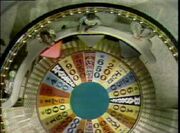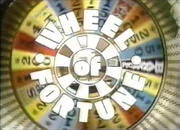
Go back to Pilot episodes, or forward to 1976?
January 1975[]
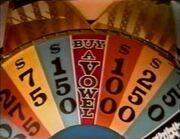
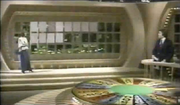
The very first puzzle.

Can you solve it?

These are just some of the many exciting prizes available!
- On January 6, Wheel airs its first episode. The show replaces Jeopardy! as per contract in the 10:30 AM slot formerly held by Winning Streak. Many changes occur from the pilots:
- Chuck Woolery and Susan Stafford are the hosts.
- The show's theme is changed to "Big Wheels" by Alan Thicke, who also supplies the show's other music cues.
- Jeff Goldstein replaces Marty Pasetta as director.
- The format is slightly altered to use three Wheel templates, with the top values now being $500 in Round 1, $750 in Round 2, and $1,000 thereafter. The number of special spaces now starts at four and increase by one each round until Round 3. The other values are also moved around a bit, with $225, $325, $375, and $425 being retired and Buy a Vowel now available from Round 1. For Round 2, a second Bankrupt is added. A second Lose a Turn and a second Buy a Vowel are added in Round 3 while Free Spin is removed. Also, the serifs at the top of each "1" move from the top to a slightly lower position, with the 1 of the $1,000 space having a noticeably flatter base than those of the three-digit values. The minimum value for Round 1 is still $25 (with only one space offering such a value) with $50 being the minimum afterwards. The number of $50 spaces is two in Round 2 and only one in Round 3.
- The placement of the special spaces still follows a certain pattern, but the pattern is noticeably different compared to that of the 1974 pilots. In addition, the largest and smallest values are no longer always placed adjacent to a penalty wedge.
- Contestants who land on Buy a Vowel and do not have $250 lose their turn (a rule that was likely in place since at least the second pilot, but this is not certain). According to one recollection, a negative score occurred at least once in the game's history, so it is not yet certain whether landing on Buy a Vowel always resulted in a lost turn if the contestant did not have enough money.
- The puzzle board trilons now turn clockwise instead of counterclockwise, and multiples of a letter light each instance one at a time. Also, the puzzle board, which previously was open behind the trilons and light border, is modified to add a backing.
- The camera zooms in to a tight shot of the puzzle board, cropped to the edges of the puzzle's trilons, when Susan is turning letters.
- Each round's category is now given outright to the players.
- The single shopping "showcase" behind the puzzle board is changed to three platforms at the back of center stage. The contestants put the showcases in a 1-2-3 order before the show; if that player solves a puzzle, they spend their money at the showcase they put as #1, with the second and third platforms respectively being used if the same contestant solves the next puzzle.
- The platforms are behind a set of panel doors similar to those of Let's Make a Deal, inside a border that resembles the puzzle board (using a 10×5 grid of what appear to be square mirrors). The doors open after each round to reveal the prize platform for that round; once Charlie finishes describing the purchased prizes, the doors close and "hookers" (stagehands with large hooks) pull the platform out of the way and set up for the next round.
- The scrolling prize/value list is replaced by a set of price cards placed on or near the prizes; these cards use black characters on a white background. A photo showing these tags appears in the first issue of the show's Off Camera newsletter in 1993.
- Each player now gets to start a round, going from left to right for Rounds 1-3 and looping around for subsequent rounds.
- The flimsy "pointers" are replaced by a set of much sturdier ones that are far more effective at stopping the Wheel.
- The Speed-Up round is introduced, signified by a four-chime bell (previously used as the end-of-round signal on Jeopardy!) to denote that time is running out. Chuck gives the Wheel a "Final Spin", and the amount that the red arrow lands on is the value of a letter in this round; if the arrow lands on a non-cash wedge, he spins again until a dollar amount is hit. The player in control when the Final Spin chimes sound gives a letter; if the letter is in the puzzle, s/he has five seconds to solve the puzzle once Susan turns them over and moves out of the way. If a wrong letter is called or the time limit expires, play passes to the next player. For most of their existence, Speed-Ups are only used when necessary, and it is not uncommon for a game not to have one. Also, rounds that start as a Speed-Up coming out of a commercial break (or go to Speed-Up immediately after a mid-round break) begin immediately with the host doing the final spin (without the category chimes or the final spin bells sounding) and their puzzle is not revealed until after the final spin. Contestants originally are not allowed to call vowels within the first 60 seconds; this time limit is denoted by the "tacky buzzer" used to indicate time expiring on The Hollywood Squares. Speed-Up rounds use a split-screen shot, with the upper half displaying the puzzle board and the lower half showing the players and their main displays (plus the "ON ACCOUNT" displays, if applicable). The only sounds used during the Speed-Up are the buzzer (when the five-second time limit expires) and the "only vowels remain" beeps.
- A sponsor list is added. If its appearance on January 19, 1976 is any indication, it is prefaced by "THE FOLLOWING HAVE PAID AND/OR FURNISHED PRIZES TO NBC FOR PROMOTING THEIR PRODUCTS", centered, above the spinning Wheel.


A mink coat!
- Bankrupt is hit at least once, a fact the weekly Variety notes in an article on the 15th.
- The first two letters revealed on the board are S and C, also the first two letters of the first word of the Round 1 puzzle.
- At one point, while contestant Gerry is spinning the Wheel, the dollar sign disappears from June's scoreboard.
- Contestant June wins at least $3,800, buying a $3,200 mink coat which she wears for the rest of the show. Following Round 3 (or possibly 4), she tells Chuck that "You're the first man who ever gave me a mink coat" while walking over to his area and giving him a kiss on the cheek.
- For the first time, a puzzle is discarded, likely Round 3 (in any case, the last puzzle of the day). During the credits, Charlie mentions the fact it was discarded, followed by an announcement that June was credited with her winnings, a new puzzle substituted, and the tape edited. This was most likely due to Susan turning a wrong letter, something she was known to have done frequently in the earliest days.
- The January 6 show is known to exist, as clips of it were used in the show's E! True Hollywood Story.
- On January 6 or shortly thereafter, Giorgio begins providing Susan's wardrobe.
- As of January 6:
- The opening is approximately the same as it was on the 1974 pilots.
- The main contestant displays are still white.
- There is still a ring of lights above the Wheel, and at least some overhead shots continue to use it.
- The center of the Wheel still changes color with each spin.
- Puzzles are still introduced with an angled shot that includes the host and Wheel.
- After the January 8 show is taped, Goldstein tells Chuck that he has never seen a game show host make a mistake and draw everyone's attention to it. Chuck responds by saying that everyone makes mistakes, so they should leave it in rather than edit it out.
- Initially, there is apparently no rule stating that puzzles must be solved exactly as they appear on the board, which was likely also the case on the pilots. The rule is believed to have been added the day after a contestant is ruled correct despite transposing the first and third words of TWEEDLEDUM AND TWEEDLEDEE.
February 1975[]

- An NBC press photo dated February 5 shows Chuck and Susan at the Rounds 3+ Wheel used on the premiere, with the doors behind them. Whether the date indicates that these elements were still in place at this point is unknown, as various publicity shots have been recycled and "re-dated" over the years.
March 1975[]
- For the week of March 10, Wheel and NBC's other daytime games (Blank Check, Celebrity Sweepstakes, High Rollers, The Hollywood Squares, and Jackpot) participate in the Shamrock Sweepstakes.
- On March 17, the biggest winner of each show from the previous week appears on Celebrity Sweepstakes, as do Chuck and NBC's other hosts (Art James, Jim MacKrell, Alex Trebek, Peter Marshall, and Geoff Edwards).
- The show begins with all twelve onstage, most likely in the six spots normally occupied by the celebrity panel; Sweepstakes regular Carol Wayne (the Lebanon Daily News claims on March 15 that Bob Hope filled this role, but this is unlikely) draws a name out of a drum, at which point the other players and their hosts are put in an isolation booth. The remaining host reads a five-part question about Irish-American people (written by Bolen and Jack Samuels, head of NBC's Compliance & Practices office), to which the player must give all five answers to win $100,000. An incorrect answer at any point means that a new name is drawn and the same question is asked by that host, continuing as necessary until a player gives all five correct answers. While the Shamrock Sweepstakes rules allow it to continue into multiple shows as needed, this ends up not being necessary.
- As of 2010, a fan held an audiocassette recording of this episode; whether this recording still exists is unknown.
- Info on the Sweepstakes, including the multi-part question and its answers, appears in Maxene Fabe's 1979 book TV Game Shows!
April 1975[]
- Sometime this month, contestant Richard Hooper wins $19,061 over four days. He later appears during the All Star Dream Machine Championship in January 1976.
May 1975[]
June 1975[]
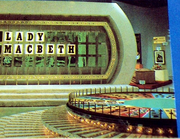
- Likely by the end of this month (according to one recollection), and definitely by November 3, the prop at center stage is removed at Merv's insistence. If the photos shown on the Milton Bradley games (see "October 1975") are any indication, the prize platforms are temporarily put behind the puzzle board, as was the case in the 1974 pilots.
- Assuming the above was the case, a golden curtain that also stretches between the puzzle board and Wheel debuts at some point afterward (no later than November 3). The curtain, decorated vertically with lights, lowers after Chuck's entrance and raises after each round to reveal the shopping prizes.
- Also assuming the above was the case, the set photos used in the Milton Bradley games are taken during this "interim" period and confirm several aspects about the show (all of which are definitely in place by October 31):
- The Round 1 Wheel layout has changed by now, with the minimum now $100: the tan $75 becomes a second $500, the sole $25 becomes $300 (if it did not increase before the other spaces), the red $50 becomes $150, the yellow $75 becomes $200, and the blue $50 becomes $100.
- The Round 3 layout is altered a bit as well, with the sole $50 becoming $150.
- The pricetags used in shopping rounds change to shorter black characters on a blue background, encased in white holders.
- The main contestant displays become the same color as the arrows (red, yellow, and blue from left to right).
- The special spaces still have their original appearance.
- Available footage of a 1975 episode of the Belgian version (Het Rad Der Fortuin) shows a Round 1 Wheel using the January 6 layout with slightly different wedge placement and the values multiplied by 10, with no 250 spaces. If this is a reflection of the American version, the sole $25 increases to $300 (and the minimum value becomes $50) before the other two-digit values are removed.
- Probably at this point, and definitely by January 19, 1976, the light ring above the players is removed and the Wheel's center no longer changes color.
July 1975[]

- A "Fun in the Morning" promo airs between about July 4 and September 26, consisting of publicity shots from Celebrity Sweepstakes, Wheel, High Rollers, The Hollywood Squares, The Magnificent Marble Machine, and Jackpot. Strangely, the Wheel pictures are one each from the Shopper's Bazaar pilot and the first Byrnes pilot.
- As of July 13, Wheel draws a 6.5 on the Nielsen ratings system with a 33 share.
- The July 15 show (#137, Mike/Laura/Bobbie) is held on audio tape by Archival Television Audio, Inc.
- By July 15:
- The intro is slightly altered, but mostly similar to the 1974 pilots: Charlie lists several prizes as the camera shows them, followed by "These are just some of the many exciting prizes available. Total retail value of all these prizes: more than [amount]! And are yours to buy today on Wheel of Fortune. And now, here's your host: Chuck Woolery!"
- The money graphic is now rounded to the nearest thousand.
- Chuck now interviews each player starting with the red position after Susan introduces them.
- The original Round 2 layout has been discarded, with the layout originally exclusive to Round 3 now used in both Rounds 2 and 3. As such, $1,000 becomes the top value in Round 2. It is possible that there is still only one Buy a Vowel space present in Round 2 at this point, but this is uncertain.
- Free Spin is now exclusive to the Round 1 layout.
- The second Lose a Turn wedge in Round 3 has been removed by this point, as evidenced by contestant Laura landing on $500 during the round. This and the above two changes likely happened when $100 became the minimum.
- During shopping rounds, contestants may now place any part of their winnings on a gift certificate in addition to the existing "on account" option; players may also place some money on account and some on a gift certificate. However, from this point until the removal of the shopping rounds, most contestants opt for the gift certificate.
- Charlie's closing spiel about the prizes is changed to "The prices of the prizes were furnished to the contestants prior to the show and have been rounded off to the nearest dollar." On January 6, this was simply "The prices of some of the prizes were furnished to the contestants prior to the show."
- On July 15:
- There is a commercial break during Round 1, which appears to have been a rarity during the daytime show's shopping era.
- None of the puzzles have T or O in them.
- As of July 15, the original Speed-Up rules are still in effect.
August 1975[]
September 1975[]
- Lin Bolen leaves NBC sometime between the beginning of this month and March 31, 1976 (a Variety article from the latter states that she was present when the Fall season began, but CBS overtook NBC by the time she left). On Wheel, this results in contestants generally playing puzzles at their own pace rather than very frequently following her insistence on playing to the last consonant to maximize winnings.
- The September 5 show (#175, Janet/Linda/Mike) is held on audio tape by Archival Television Audio, Inc.
- As of September 5:
- There is still no sound played when each puzzle is revealed.
- The thin-flap "pointers" are still in use.
- Buy a Vowel is still present.
- Contestants still order the prize platforms 1-2-3 before the show, which in turn are tied to each of the first three rounds.
- On September 5:
- The money graphic (and Charlie's associated spiel) is $19,000. This is the lowest known amount displayed on the "large" money graphic, barring the eventual Jackpot and Cashpot graphics.
- No letters are revealed in Round 1 until the seventh turn.
- There is a commercial break during Round 1.
- As of September 12, Wheel draws a 31 share on the Nielsen ratings system, 2nd place among all daytime network games (trailing only Celebrity Sweepstakes).
October 1975[]
- By the end of this month, Milton Bradley releases two board game adaptations; they are the only ones to be released in the 1970s, and the only ones to use the shopping element. As mentioned under "June 1975", the pictures used on the box and instruction booklet show a set that does not use the doors or curtain; rather, the prizes are behind the puzzle board.
- These games confirm several gameplay aspects about the show at the time of their release, including:
- The categories in use at this point: Event, Fictional Character, Landmark, Person, Phrase, Place, Thing, and Title. An old version of the show's website stated that Wheel began with six categories, while one recollection claims that Phrase did not exist in the earliest months. It is likely that the puzzles were still only Person, Place, or Thing when the show debuted (and in the July 15 and September 5 shows, these are the only categories which appear), with Fictional Character, Landmark, and Event being extensions; if so, Phrase and Title are the two "additional" categories.
- Punctuation is still ignored (i.e., FISHERMANS WHARF instead of FISHERMAN'S WHARF).
- There is still no rule stating that puzzles must be solved exactly as they appear on the board (although given the absence of the "only vowels remain" rule, this may be an oversight by Milton Bradley).
- The above board games' rules state that players may not buy vowels at their discretion and must land on Buy a Vowel to do so. While this was long believed to also be the case on the show, it very likely was not, as the September 5 show, in which this rule was not in effect, was almost certainly taped by the time the First Edition game finished production.
- Sometime between the release of the First Edition and that of the Second, at least Thing and Person begin using their respective plural forms (Things and People, respectively).
November 1975[]
- Sometime this month, contestant Patti Butler wins $18,300 over five days. She later appears during the All Star Dream Machine Championship in January 1976.
- November 3 is NBC's Daytime Gigantic Game Gala, a week-long celebration involving Wheel, Celebrity Sweepstakes, The Hollywood Squares, and The Magnificent Marble Machine.
- Wheel airs for a full hour this week, resulting in the only known week with three hour-long daytime network games (the others being Squares, celebrating the start of its 10th year, and The Price Is Right, which was a permanent expansion). Changes for the hour format include the following:
- Three contestants (including the returning champion, if applicable) play a three-round game with $1,000, $2,000, and $2,500 as the top values. Immediately afterward, a second set of contestants play a three-round game much like the first.
- The winner of each game plays a one-round "Head-To-Head All-Cash Showdown", itself with several unique rules:
- The puzzle for the round is chosen in front of the puzzle board (displaying WHEEL OF FORTUNE) from one of three bowls marked by category. The top winner going into the round chooses the puzzle; their opponent gets the first turn of the round.
- The Wheel has a top value of $2,500 and a special marker which corresponds to a bonus prize. A contestant must land on it and guess a correct letter to pick it up, and they must solve the puzzle to win it. If a contestant hits Bankrupt while holding the Prize marker, it is placed back on the Wheel.
- This round can include a Final Spin if necessary.
- The contestant with the higher total after this round is declared champion, regardless of whether that contestant solved the puzzle.
- During the week of November 3:
- Wheel airs from 10:30-11:30 AM, The Magnificent Marble Machine at 10:00 AM, The Hollywood Squares from 11:30 AM-12:30 PM, and Celebrity Sweepstakes at 12:30 PM. Neither High Rollers nor 3 for the Money air this week.
- The contestant interviews are done at a quicker pace, with a loop of the "Big Wheels" bridge playing in the background.
- Charlie introduces Game 2 with: "Welcome back to the second half of our one-hour version of Wheel of Fortune. And now, once again, here's Chuck Woolery!"
- The budget is increased for this week:
- The normal Round 3 layout is used for Round 1, with $1,000 as top value and a (dark orange) Free Spin wedge in place of the Bankrupt near Lose a Turn. The sole $175 on this layout is increased to $200, which probably only lasts for this week.
- A unique layout (or possibly an early version of the 1976 Round 3 layout) is used for Rounds 2-3. This layout also includes $550 (in its only known appearance between the pilots and 1979), $1,000, and the first known appearances of $850 and $1,500.
- The bonus prize is a luxury car, including a 1976 Cadillac Eldorado coupe on November 3 and a Jaguar XJ coupe on November 6.
- This week establishes that hour-long shows do not contain mid-round commercial breaks. It also suggests that each half may contain no more than three rounds.
- By November 3:
- The opening is slightly altered to remove the chroma-key zoom-out of the prizes. It otherwise appears to be the same as it was on the premiere.
- Chuck now enters from the contestants' right and walks up to his part of the railing.
- A four-note chime now plays at the start of each round.
- Buy a Vowel is retired. The Round 1 layout replaces it with a red $400.
- Bankrupt, Lose a Turn, and Free Spin adopt their normal appearances. It is possible that this change took place before Buy a Vowel was removed, but this cannot currently be confirmed.
- The curtain has definitely replaced the doors.
- The November 3 show is known to exist, as a 20-second clip of the opening was shown on the March 21, 2000 episode of The Roseanne Show (known to have been reshown on July 5, 2000), on which Chuck was a guest.
- On November 6 (Marie/Dean/Sherri and Anna/Maureen/Jim):
- The show is partially pre-empted by NBC News coverage of a press conference with U.S. President Gerald Ford. The show is joined-in-progress approximately five minutes into the episode.
- During Round 3 of Game 1, Sherri offers her Free Spin to Chuck just as Marie spins. Chuck accepts the Free Spin and declares Marie's spin invalid.
- During Round 3 of Game 2, Jim spins just as the Final Spin bell rings. Chuck lets the spin count and it lands on Lose a Turn.
- Charlie announces during the credits that an audience member called out an answer during the Head-To-Head Round, a new puzzle was substituted, and the tape edited.
- As of November 6, there is still no punctuation being used in the puzzles.
- The November 6 show is held on audio tape by Archival Television Audio, Inc.
- It is likely that the aforementioned Wheel layout alterations are removed on November 10.
- Wheel does not air on November 27 due to the Macy's Thanksgiving Day Parade.
December 1975[]
- On December 1, Wheel again expands to 11:30; as a result, High Rollers moves to Noon and The Magnificent Marble Machine moves to 12:30. The hour-long format used in November is reintroduced, with the following changes:
- The end of the opening spiel is changed to "...on the new, one-hour version of Wheel of Fortune!"
- The top values in Rounds 1-3 for both games are $500-$1,000-$1,500. The top value for the Head-To-Head All-Cash Showdown is $2,000.
- A whole new template is introduced for Round 3 (and presumably used during the Head-To-Head Round as well). Half of it is likely identical to the known 1976 Round 3 template (containing $1,500 and $850). The other half appears to be unique to the permanent hour-long shows and is known to contain $650, $700, and $1,000.
- The bonus prize is no longer a car every day. As such, the bonus prize marker, which read "CAR" in November, is changed to "BONUS".
- Per the Toledo Blade, Wheel does not air on December 25 due to Christmas Day programming.
- The December 29 show is partially held on audio tape by Archival Television Audio, Inc. The recording consists of just the first 11 minutes, due to the source tape running out.
- Late this month, including December 30-31, contestant Rick Mandl wins $22,475 over four days, including a luxury car in the Bonus Round. He later appears during the All Star Dream Machine Championship in January 1976.
